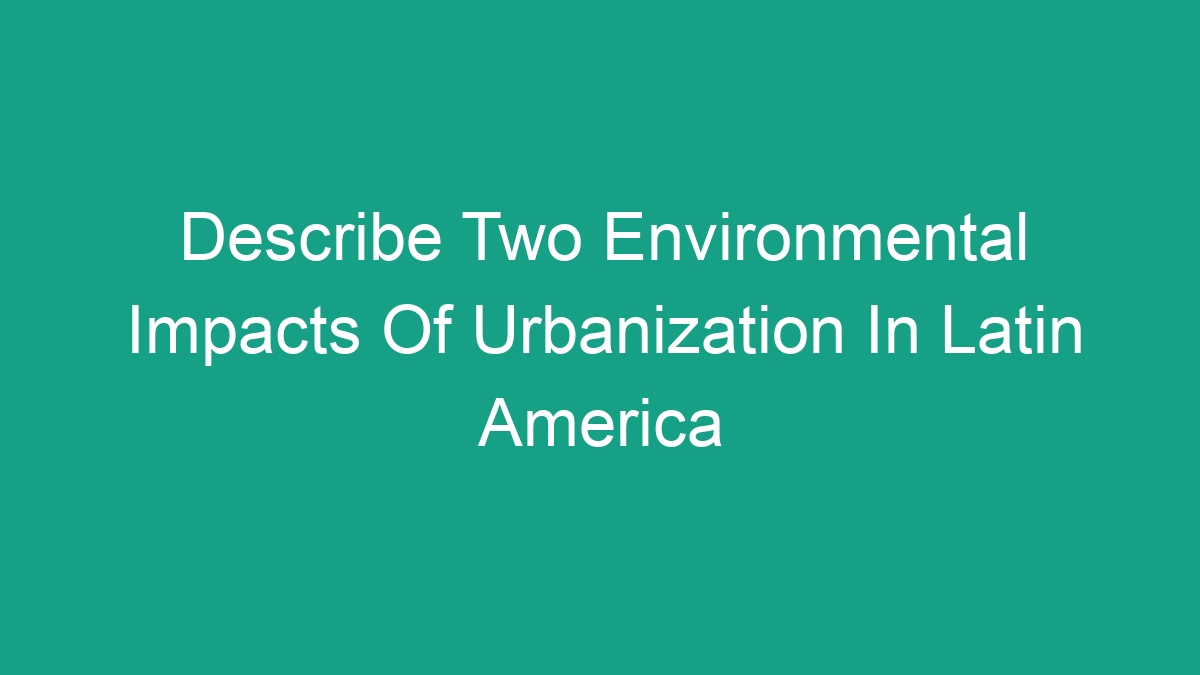
Introduction
Urbanization in Latin America has been on the rise for decades, with millions of people migrating from rural areas to cities in search of better employment opportunities and improved living standards. This rapid urban growth has had a profound impact on the environment, leading to a range of environmental issues that pose significant challenges for the region. In this article, we will describe two major environmental impacts of urbanization in Latin America and discuss potential solutions to address these issues.
Air Pollution
One of the most significant environmental impacts of urbanization in Latin America is air pollution. As cities grow, so does the number of vehicles on the roads, industrial activities, and energy consumption, all of which contribute to the release of harmful air pollutants. In rapidly urbanizing cities like Mexico City, São Paulo, and Buenos Aires, air pollution has become a major concern for public health and the environment.
The primary sources of air pollution in urban Latin America include vehicular emissions, industrial activities, and the burning of fossil fuels for energy production. These activities release a range of pollutants, including particulate matter, nitrogen oxides, sulfur dioxide, carbon monoxide, and volatile organic compounds, all of which have detrimental effects on human health and the environment.
These pollutants can lead to a range of health issues, including respiratory diseases, cardiovascular problems, and even premature death. Additionally, air pollution can have damaging effects on ecosystems, leading to the acidification of soils and water bodies, and impacting the health of plant and animal species.
Deforestation and Habitat Loss
Another significant environmental impact of urbanization in Latin America is deforestation and habitat loss. As cities expand, natural habitats are often cleared to make way for residential and commercial developments, leading to the destruction of critical ecosystems and the loss of biodiversity.
In countries like Brazil, deforestation in the Amazon rainforest is driven both by urban expansion and agricultural activities, as land is cleared for farming and ranching. This has resulted in the loss of crucial habitat for countless plant and animal species, leading to a decline in biodiversity and ecological imbalances.
Deforestation also contributes to climate change, as trees and forests act as carbon sinks, absorbing carbon dioxide from the atmosphere. When forests are cleared, this stored carbon is released back into the atmosphere, contributing to the greenhouse effect and global warming.
Furthermore, the loss of natural habitats can have cascading effects on local and regional ecosystems, leading to the displacement and extinction of species, disruption of ecological processes, and the degradation of ecosystem services that are vital for human well-being.
Solutions and Mitigation Strategies
Addressing the environmental impacts of urbanization in Latin America requires a multi-faceted approach that involves policy interventions, community engagement, and sustainable urban planning. Here are some potential solutions and mitigation strategies to address the environmental challenges posed by urbanization:
– Investment in Public Transport: One of the most effective ways to reduce air pollution in urban Latin America is to invest in public transportation systems. By providing affordable, efficient, and reliable public transport options, cities can reduce the reliance on private vehicles, leading to lower emissions and improved air quality.
– Adoption of Clean Energy Technologies: Encouraging the adoption of clean energy technologies, such as solar and wind power, can help reduce the reliance on fossil fuels for energy production, thereby mitigating air pollution and reducing greenhouse gas emissions.
– Implementation of Green Infrastructure: Implementing green infrastructure, such as green roofs, urban parks, and tree-lined streets, can help mitigate the impacts of urbanization by absorbing pollutants, reducing the urban heat island effect, and providing critical habitat for wildlife.
– Land-Use Planning and Conservation: Strict land-use planning regulations and the conservation of natural habitats are crucial for preserving biodiversity and reducing the environmental impacts of urban expansion. This includes the designation of protected areas, the enforcement of sustainable land-use practices, and the implementation of reforestation programs.
– Public Awareness and Education: Public awareness and education campaigns can play a critical role in promoting sustainable behaviors and fostering a sense of environmental stewardship among urban residents. By raising awareness about the impacts of urbanization on the environment, communities can work together to implement sustainable practices and advocate for environmentally friendly policies.
Conclusion
Urbanization in Latin America has undoubtedly had profound environmental impacts, with air pollution and deforestation emerging as major challenges for the region. However, by implementing sustainable urban planning practices, investing in clean energy technologies, and engaging local communities, it is possible to address these environmental challenges and create healthier, more sustainable cities for the future. With concerted efforts from governments, businesses, and citizens, Latin America can work towards mitigating the environmental impacts of urbanization and building a more resilient and environmentally friendly urban environment.



